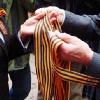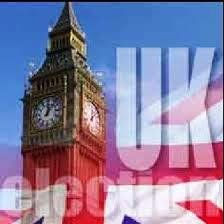(Monkey Cage/WP) (Co-authored with Sean Roberts) A “War of Lapels” is raging as many people in the post-Soviet space must make political choices about what to wear on their jackets on May 9 to commemorate the 70th anniversary of the end of World War II in Europe. How citizens accessorize broadcasts their position on the conflict between Russia and Ukraine.
In many ways, Vladimir Putin has framed Russia’s conflict with Ukraine over the past year around a particular historical narrative of World War II that promotes a mélange of Soviet greatness with Russian nationalism, while branding Ukrainians as fascists. The Kremlin storyline of World War II is in stark contrast to the narrative honored by most living in Ukraine and other parts of Eastern Europe, where remembering the war is not related to present-day political disputes but honors the sacrifices of family members alive at that time.
This transformation of the Soviet narrative of the war into a Russian nationalist one has been particularly apparent in Russian-Ukrainian relations. In response to Ukraine’s rehabilitation of Stepan Bandera, for example, Russia publicly condemned the Ukrainian government and frequently characterized western Ukrainians as fascists on Russian television. In addition, Moscow sought to convince Russian-speaking Ukrainians and the citizens of other post-Soviet states of the dangers of a growing anti-Russian Ukrainian fascism.
In the run-up to the May 9 holiday this year, Moscow is promoting its connections between World War II and the war in eastern Ukraine through an unlikely strategy – by trying to monopolize the lapels of post-Soviet citizens. This situation has its origins in an ingenious, participatory, and continually evolving Russian nationalist propaganda campaign originally created by Putin’s administration in 2005 as part of the 60th anniversary of Victory Day – the wearing of the Ribbon of St. George or the Georgievskaya Lenta. Since 2005, the Georgievskaya Lenta, an orange-and-black-striped ribbon associated with an 18th century czarist Russian military medal, has become an increasingly important part of celebrating the end of World War II in Russia, and it has also been exported by Russia to other post-Soviet states as an overtly Russian symbol of these states’ shared history in the Soviet defeat of Nazi Germany.
While this ribbon has generated controversy in the non-Russian post-Soviet states since its introduction in 2005, over the past two years the ribbon has taken on more overtly Russian nationalist meaning in the context of the Russian-Ukraine war. As a result, the ribbon no longer only represents a remembrance of those from throughout the Soviet Union who gave their lives to defeat Nazi Germany; it also represents a symbol of Russia’s historical and present role in preventing the spread of what it calls fascism, which includes its efforts to undermine Ukraine’s present government. In this sense, the wearing of the Georgievskaya Lenta now also expresses explicit support of Putin’s nationalist agenda in Russia and opposition to Ukraine’s new government and its reform efforts.
As one might expect, it is very unlikely that Ukrainians outside those areas controlled by the Russian-backed rebels will wear the Georgievskaya Lentathis year on May 9. In the context of the war, Ukrainians are becoming only more united in their patriotism and opposition to Russia. Furthermore, the Ukrainian government has decided to adopt a different decoration to celebrate the defeat of Nazism this year – a poppy flower, mimicking that worn throughout the British Commonwealth nations and in the United States.
This symbolic “war of lapels” has spread throughout the post-Soviet space and threatens to divide the populations of many former Soviet states at a time when they would otherwise be celebrating peace and the sacrifices of their loved ones who had suffered so much during World War II. In Moldova, the Liberal party has taken a strong stance against the Russian World War II narrative, seeking to outlaw the Georgievskaya Lenta as a foreign military symbol. In an attempt to avoid appearing to either support or condemn the Russian narrative, Kyrgyzstan has quietly created their own version of the Russian ribbon by replacing its colors with those of the Kyrgyz flag (red and yellow).
In Kazakhstan, which is one of Russia’s closest allies, but also has a large, often restless ethnic Russian minority and is desperately trying not to take sides in the Russia-Ukraine conflict, the state has also created its own Kazakh ribbon based on its national flag adorned with Soviet medals. So as not to appear to be countering Russia’s distribution of the Georgievskaya Lenta in Kazakhstan, the state has been careful to point out that citizens can wear any lapel decoration they choose. Although this strategy is in line with Kazakhstan’s usual “multi-vector” foreign policy, it is also inviting tension in the country as groups of citizens are beginning to mobilize both for and against the Georgievskaya Lenta.
At a time when many former Soviet citizens wish to honor a generation who gave so much to stop Nazi aggression 70 years ago, this war of symbols is only polluting popular memory and manipulating it to promote current political purposes. Putin’s strategy of using WWII-era victories to support his own aggression in eastern Ukraine will likely backfire over the long run, at least among those former Soviet citizens living outside Russia. In particular, it likely will create new divisions and conflicts within those post-Soviet states seeking to remain neutral in the Russia-Ukraine conflict.
– – – – – – – – –
See the original post at The Monkey Cage











